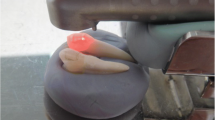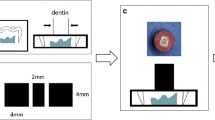Abstract
Purpose
The aim of this study is to compare the bond strength, fracture type, and the amount of microleakage related to lingual retainers bonded on enamel surface etched with either Erbium:Yttrium-Aluminum-Garnet (Er:YAG) laser or acid etching methods.
Methods
The enamel of extracted 132 upper incisor teeth was etched using either 37% phosphoric acid or Er:YAG laser (Fotona Light Walker H02-N 2940 nm, 120 mJ, 10 Hz, 1.2 W in MSP mode). Teeth were embedded in acrylic as two teeth in each sample with 135° angulation and retainer wires were bonded on the lingual surface of the samples. Two-year aging protocol was applied using a chewing simulator and a thermal cycler. Shear bond strength (SBS), adhesive remnant index (ARI), and microleakage were measured.
Results
SBS and microleakage data were analyzed using the Mann–Whitney U test and ARI scores using the Pearson chi-square test. The SBS was found significantly higher in the acid-etched group. There was no statistically significant difference in the total microleakage means between groups. There was no statistically significant difference in the microleakage between the enamel-adhesive and adhesive-retainer interfaces for the mesial and distal sides. Higher microleakage values were measured between the enamel and the adhesive surfaces compared to adhesive-retainer interface for both groups.
Conclusion
Within the limitations of our study, acid etching promises better bond strength for lingual retainers compared to Er:YAG laser etching. There was no significant difference between the groups in terms of microleakage.





Similar content being viewed by others
References
Fowler BO, Kuroda S (1986) Changes in heated and in laser-irradiated human tooth enamel and their probable effects on solubility. Calcif Tissue Int 38:197–208
Keller U, Hibst R (1990) Ultrastructural changes of enamel and dentin following Er:YAG laser radiation on teeth. OE/LASE'90, 14–19 Jan, 408–415
Lai C, Grossen J, Renkema A, Bronkhorst E, Fudalej P, Katsaros C (2014) Orthodontic retention procedures in Switzerland. Swiss Dent J 124:655–661
Taylor MJ, Lynch E (1992) Microleakage. J Dent 20:3–10
Kidd EA (1976) Microleakage in relation to amalgam and composite restorations. A laboratory study. Br Dent J 141:305–310
Going RE (1972) Microleakage around dental restorations: a summarizing review. J Am Dent Assoc 84:1349–1357
Alani AH, Toh CG (1997) Detection of microleakage around dental restorations: a review. Oper Dent 22:173–185
Lüscher B, Lutz F, Ochsenbein H, Mühleman H (1978) Microleakage and marginal adaptation of composite resin restorations. J Prosthet Dent 39:409–413
Nimbalkar-Patil S, Vaz A, Patil P (2014) Comparative evaluation of microleakage of lingual retainer wires bonded with three different lingual retainer composites: an in vitro study. J Clin Diagn Res 8(11):83–87
Bulut A, Atsu S (2016) Aging procedures of dental restorative materials and chewing simulator. J Dent Fac Atatürk Uni 26:180–186
Veli I, Akın M, Kucukyılmaz E, Uysal T (2014) Shear bond strength of a self-adhering flowable composite when used for lingual retainer bonding. J Orofac Orthop 75:374–383
Årtun J, Bergland S (1984) Clinical trials with crystal growth conditioning as an alternative to acid-etch enamel pretreatment. Am J Orthod 85:333–340
Osorio R, Toledano M, Garcia-Godoy F (1999) Bracket bonding with 15 or 60 second etching and adhesive remaining on enamel after debonding. Angle Orthod 69:45–48
Mitchell L (1992) Decalcification during orthodontic treatment with fixed appliances--an overview. Br J Orthod 19:199–205
Gorelick L, Geiger AM, Gwinnett AJ (1982) Incidence of white spot formation after bonding and banding. Am J Orthod 81:93–98
Ogaard B (1989) Prevalence of white spot lesions in 19-year-olds: a study on untreated and orthodontically treated persons 5 years after treatment. Am J Orthod Dentofac Orthop 96:423–427
Usumez S, Orhan M, Usumez A (2002) Laser etching of enamel for direct bonding with an Er,Cr:YSGG hydrokinetic laser system. Am J Orthod Dentofac Orthop 122:649–656
Lee BS, Hsieh TT, Lee YL, Lan WH, Hsu YJ, Wen PH (2003) Bond strengths of orthodontic bracket after acid-etched, Er:YAG laser-irradiated and combined treatment on enamel surface. Angle Orthod 73:565–570
Moshonov J, Stabholz A, Zyskind D, Sharlin E, Peretz B (2005) Acid-etched and erbium:yttrium aluminium garnet laser-treated enamel for fissure sealants: a comparison of microleakage. Int J Paediatr Dent 15:205–209
Miresmaeili A, Farhadian N, Rezaei-soufi L, Saharkhizan M, Veisi M (2014) Effect of carbon dioxide laser irradiation on enamel surface microhardness around orthodontic brackets. Am J Orthod Dentofac Orthop 146:161–165
Hamamci N, Akkurt A, Basaran G (2010) In vitro evaluation of microleakage under orthodontic brackets using two different laser etching, self etching and acid etching methods. Lasers Med Sci 25:811–816
Lorenzo MC, Portillo M, Moreno P, Montero J, Garcia A, Santos-del Riego SE (2015) Ultrashort pulsed laser conditioning of human enamel: in vitro study of the influence of geometrical processing parameters on shear bond strength of orthodontic brackets. Lasers Med Sci 30:891–900
Sagir S, Usumez A, Ademci E, Usumez S (2013) Effect of enamel laser irradiation at different pulse settings on shear bond strength of orthodontic brackets. Angle Orthod 83:973–980
Berk N, Basaran G, Ozer T (2008) Comparison of sandblasting, laser irradiation, and conventional acid etching for orthodontic bonding of molar tubes. Eur J Orthod 30:183–189
Martinez-Insua A, Da Silva Dominguez L, Rivera FG, Santana-Penin UA (2000) Differences in bonding to acid-etched or Er:YAG-laser-treated enamel and dentin surfaces. J Prosthet Dent 84:280–288
Usumez S, Malkoc S (2000) Er,Cr,:YSGG hidrokinetik laser sistemiyle mine pürüzlendirilmesinin ortodontik apareylerin yapışma kuvvetine etkisı̇. Cumhuriyet Üniversitesi Dişhekimliği FakÜltesi Dergisi 3:6–8
Cehreli SB, Gungor HC, Karabulut E (2006) Er,Cr:YSGG laser pretreatment of primary teeth for bonded fissure sealant application: a quantitative microleakage study. J Adhes Dent 8:381–386
Borsatto MC, Corona SA, Ramos RP, Liporaci JL, Pecora JD, Palma-Dibb RG (2004) Microleakage at sealant/enamel interface of primary teeth: effect of Er:YAG laser ablation of pits and fissures. J Dent Child (Chic) 71:143–147
Vandevska-Radunovic V, Espeland L, Stenvik A (2013) Retention: type, duration and need for common guidelines. A survey of Norwegian orthodontists. Orthodontics 14:2–9
Beuer F, Stimmelmayr M, Gueth JF, Edelhoff D, Naumann M (2012) In vitro performance of full-contour zirconia single crowns. Dent Mater 28:449–456
Heydecke G, Zhang F, Razzoog ME (2001) In vitro color stability of double-layer veneers after accelerated aging. J Prosthet Dent 85:551–557
Kheradmandan S, Koutayas SO, Bernhard M, Strub JR (2001) Fracture strength of four different types of anterior 3-unit bridges after thermo-mechanical fatigue in the dual-axis chewing simulator. J Oral Rehabil 28:361–369
Begazo CC, de Boer HD, Kleverlaan CJ, van Waas MA, Feilzer AJ (2004) Shear bond strength of different types of luting cements to an aluminum oxide-reinforced glass ceramic core material. Dent Mater 20:901–907
Clausen JO, Tara MA, Kern M (2010) Dynamic fatigue and fracture resistance of non-retentive all-ceramic full-coverage molar restorations. Influence of ceramic material and preparation design. Dent Mater 26:533–538
Toodehzaeim MH, Yassaei S, Taherimoghadam S (2015) Comparison of microleakage under rebonded stainless steel orthodontic brackets using two methods of adhesive removal: sandblast and laser. J Dent (Tehran) 12:118–124
Arhun N, Arman A, Cehreli SB, Arikan S, Karabulut E, Gulsahi K (2006) Microleakage beneath ceramic and metal brackets bonded with a conventional and an antibacterial adhesive system. Angle Orthod 76:1028–1034
Uysal T, Ulker M, Baysal A, Usumez S (2008) Different lingual retainer composites and the microleakage between enamel-composite and wire-composite interfaces. Angle Orthod 78:941–946
Al Shamsi A, Cunningham J, Lamey P, Lynch E (2006) Shear bond strength and residual adhesive after orthodontic bracket debonding. Angle Orthod 76:694–699
Linn BJ, Berzins DW, Dhuru VB, Bradley TG (2006) A comparison of bond strength between direct-and indirect-bonding methods. Angle Orthod 76:289–294
Hosseini M, Namvar F, Chalipa J, Saber K, Chiniforush N, Sarmadi S, Mirhashemi AH (2012) Comparison of shear bond strength of orthodontic brackets bonded to enamel prepared by Er:YAG laser and conventional acid-etching. J Dent (Tehran) 9:20–26
Reynolds I (1975) A review of direct orthodontic bonding. Br J Orthod 2:171–178
Funding
This study was supported by Bezmialem Vakif University Scientific Research Projects Unit with the project number 1.2017/7.
Author information
Authors and Affiliations
Corresponding author
Ethics declarations
Conflict of interest
The authors declare that they have no conflict of interest.
Ethical approval
The study was approved and followed by Non-Invasive Research Ethics Committee of Bezmialem Vakif University.
Additional information
Publisher’s note
Springer Nature remains neutral with regard to jurisdictional claims in published maps and institutional affiliations.
Rights and permissions
About this article
Cite this article
Kurt Biyiklioglu, M., Yilmaz, B. Comparison of Er:YAG laser and acid etching methods prior to lingual retainer application in vitro. Laser Dent Sci 3, 199–207 (2019). https://doi.org/10.1007/s41547-019-00071-w
Received:
Accepted:
Published:
Issue Date:
DOI: https://doi.org/10.1007/s41547-019-00071-w




